Advances in MR Fingerprinting
Oral
Acquisition, Reconstruction & Analysis
Wednesday, 20 June 2018
| N01 |
08:15 - 10:15 |
Moderator: Nicole Seiberlich |
08:15
|
0673.
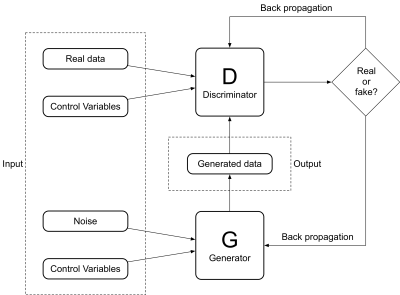 |
 Game of Learning Bloch Equation Simulations for MR Fingerprinting Game of Learning Bloch Equation Simulations for MR Fingerprinting
Mingrui Yang, Yun Jiang, Dan Ma, Bhairav Mehta, Mark Griswold
An MR fingerprinting (MRF) dictionary can be difficult to generate, especially when the dictionary calculation involves complicated physics. We present a new method, named MRF-GAN, based on the generative adversarial network (GAN) to create MR fingerprints. We demonstrate that MRF-GAN can generate accurate MRF fingerprints and the associated in vivo MRF maps comparing to the conventional MRF dictionary. Moreover, it can significantly reduce the dictionary generation time which opens the door to rapid calculation and optimization of MRF dictionaries with more complex physics.
|
08:27
 |
0674.
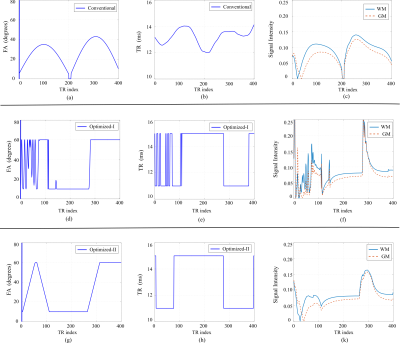 |
 Optimal Experiment Design for Magnetic Resonance Fingerprinting: New Insights and Further Improvements Optimal Experiment Design for Magnetic Resonance Fingerprinting: New Insights and Further Improvements
Bo Zhao, Justin Haldar, Congyu Liao, Dan Ma, Mark Griswold, Kawin Setsompop, Lawrence Wald
The Cramer-Rao bound (CRB) based experiment design was previously described to optimize the SNR efficiency of MRF experiments. Here we revisit such a problem and provide new insights. Specifically, we present a new CRB-based experiment design approach, which introduces an additional set of constraints on the variation of flip angles to enforce the smoothness of the magnetization evolution. We demonstrate that the proposed approach is advantageous for highly-undersampled MRF experiments. We evaluated the effectiveness of the proposed approach with both simulations and phantom experiments.
|
08:39
 |
0675.
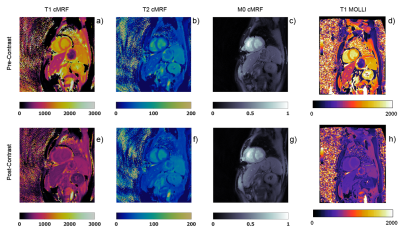 |
 Cardiac Magnetic Resonance Fingerprinting in Heart Transplant Recipients Cardiac Magnetic Resonance Fingerprinting in Heart Transplant Recipients
Andrew Coristine, Jesse Hamilton, Ruud van Heeswijk, Roger Hullin, Nicole Seiberlich
Cardiac MRF (cMRF) has recently emerged as a method of rapidly characterizing myocardial tissue. It has been shown to be robust to different and varying heart rates with high reproducibility in T1 and T2 regardless of the length and regularity of the cardiac cycle. While these techniques have been validated in healthy volunteers, patient studies have yet to be performed. Therefore, in this abstract, we present the first use of cMRF in a patient population - heart transplant recipients - and show initial results.
|
08:51
 |
0676.
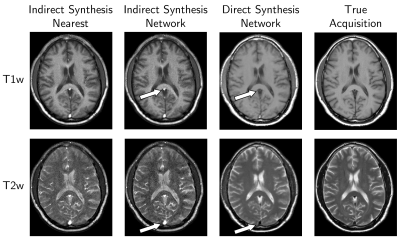 |
 Learning Contrast Synthesis from MR Fingerprinting Learning Contrast Synthesis from MR Fingerprinting
Patrick Virtue, Jonathan Tamir, Mariya Doneva, Stella Yu, Michael Lustig
MR fingerprinting provides quantitative parameter maps from a single acquisition, but it also has the potential to reduce exam times by replacing traditional protocol sequences with synthetic contrast-weighted images. We present an empirical "artifact noise" model that makes it possible to train neural networks that successfully transform noisy and aliased MRF signals into parameter maps, which are then used to synthesize contrast-weighted images. We also demonstrate that a trained neural network can directly synthesize contrast-weighted images, bypassing incomplete simulation models and their associated artifacts.
|
09:03
|
0677.
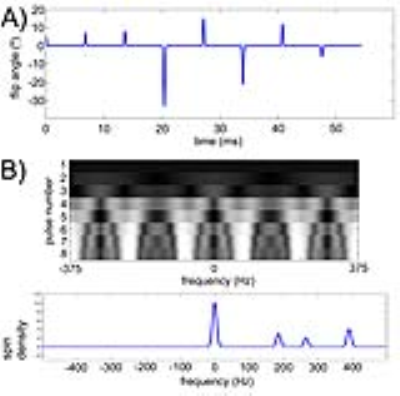 |
 MR Fingerprinting for High Resolution Metabolic Imaging of Hyperpolarized [1-13C]Pyruvate MR Fingerprinting for High Resolution Metabolic Imaging of Hyperpolarized [1-13C]Pyruvate
Cornelius von Morze, Eugene Milshteyn, Peder Larson, Galen Reed, John Pauly, Duan Xu, Daniel Vigneron
The purpose of this study was to investigate a new application of MR fingerprinting (MRF) methods for hyperpolarized 13C MRI. We show that introducing randomization of pulse parameters into a 13C SSFP acquisition train facilitates efficient extraction of individual hyperpolarized 13C metabolite levels based on their transient signal responses (i.e. "fingerprints"), in simulations as well as phantom and in vivo experiments. Application of MRF methods in this multi-spectral SSFP framework enables exploitation of the long T2 relaxation times of 13C nuclei for increased sensitivity and spatial resolution in hyperpolarized MRI. Initial results show that MRF approaches have great potential for application to hyperpolarized 13C metabolic imaging.
|
09:15
|
0678.
 |
 MR Vascular Fingerprinting during Gas Challenges MR Vascular Fingerprinting during Gas Challenges
Thomas Christen, Wendi Ni, Jia Guo, Audrey Fan, Michael Moseley, Greg Zaharchuk
The MR vascular fingerprinting (MRvF) approach extends the concept of MR fingerprinting to the study of microvascular properties and functions. Encouraging results have been obtained in healthy human volunteers as well as in stroke and tumor models in rats. However, it has been suggested that the method has a low sensitivity to blood oxygenation measurements. In this study, we tested the MRvF approach in healthy volunteers while breathing different gas mixtures (Hyperoxia (100%O2), Normoxia (21%O2), hypoxia (14%O2)) and examined the results when different types of fingerprints are considered.
|
09:27
|
0679.
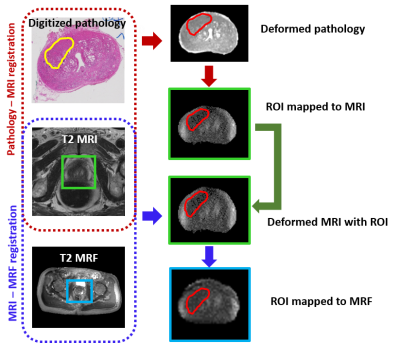 |
 Correlation of MR fingerprinting with whole mount histopathology reveals epithelial and stromal density drive T1, T2 measurements in regions of prostatitis and prostate cancer: Preliminary findings Correlation of MR fingerprinting with whole mount histopathology reveals epithelial and stromal density drive T1, T2 measurements in regions of prostatitis and prostate cancer: Preliminary findings
Rakesh Shiradkar, Ananya Panda, Shivani Pahwa, Lin Li, Patrick Leo, Nafiseh Janaki, Lee Ponsky, Robin Elliott, Vikas Gulani, Anant Madabhushi
Magnetic Resonance Fingerprinting (MRF) is a new technology aimed at generating quantitative T1 and T2 maps. In this study, histo-morphometric attributes that may be driving the MRF measurements of cancerous and prostatitis regions are explored via correlation of in vivo MRF maps with post surgical ex vivo histopathology. Our results suggest that epithelial density may be driving T1 and T2 MRF measurements in prostatitis regions while stromal density may be driving the T1 MRF signals within cancerous regions.
|
09:39
 |
0680.
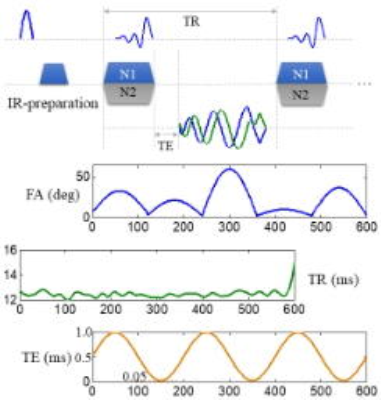 |
 Quantification of Long and Ultra-short Relaxation Times in Tissues with Ultra-short TE MR Fingerprinting (UTE-MRF) Quantification of Long and Ultra-short Relaxation Times in Tissues with Ultra-short TE MR Fingerprinting (UTE-MRF)
Qing Li, Xiaozhi Cao, Huihui Ye, Congyu Liao, Hongjian He, Jianhui Zhong
Magnetic resonance fingerprinting (MRF) has been combined with ultra-short echo time technique (UTE-MRF) to enable the quantification of ultra-short T2/T2* tissues. A TE sinusoidal variation pattern is introduced to UTE-MRF acquisition to improve the ultra-short T2detection accuracy to sub-millisecond. With the golden angle spiral acquisition and sliding window reconstruction, quantitative T1 and T2 maps of regular and ultra-short T2/T2* tissue components are acquired at 14s per slice. Since the B0 induced phase variation has been encoded into the signal evolution with variable TE, the B0 map is simultaneously obtained.
|
09:51
|
0681.
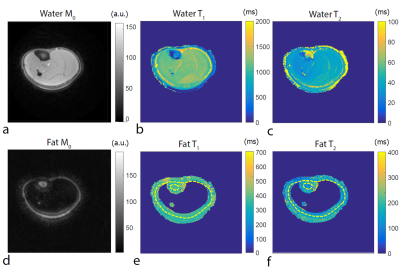 |
 Water-Fat Separation in Spiral Magnetic Resonance Fingerprinting using Conjugate Phase Reconstruction Water-Fat Separation in Spiral Magnetic Resonance Fingerprinting using Conjugate Phase Reconstruction
Kirsten Koolstra, Andrew Webb, Peter Koken, Kay Nehrke, Peter Börnert
Water-fat separation can improve the quality of tissue parameter maps in quantitative imaging methods such as Magnetic Resonance Fingerprinting (MRF). We propose such a technique that uses the B0 map as prior information for spiral off-resonance correction through conjugate phase reconstruction, enabling efficient water-fat separation with only two echo points per frame, implemented in a single run MRF approach. With this technique, accurate tissue parameter maps can be produced in the presence of fat.
|
10:03
|
0682.
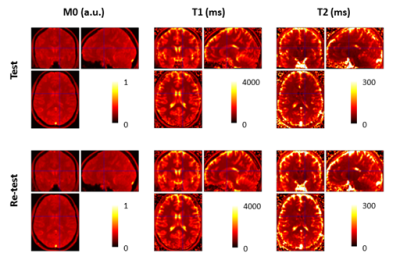 |
 Repeatability of 2D FISP MR Fingerprinting in the Brain at 1.5T and 3.0 T Repeatability of 2D FISP MR Fingerprinting in the Brain at 1.5T and 3.0 T
Guido Buonincontri, Laura Biagi, Alessandra Retico, Michela Tosetti, Paolo Cecchi, Mirco Cosottini, Pedro Gómez, Rolf Schulte, Mary McLean, Frank Riemer, Ferdia Gallagher, Martin Graves, Joshua Kaggie
MR Fingerprinting is a new multi-contrast imaging method that is appealing for its ability to acquire multiple quantitative maps efficiently when compared to other repeated acquisitions varying a single parameter at a time. This work shows our first demonstration of MRF in vivo repeatability through test/re-test imaging of seven healthy human volunteers at 1.5T and 3.0T. We found the group root-mean-square-difference (NRMSD) of MRF-SSFP T1 measurements to be 5-6% in grey and white matter at 1.5T and 4-5% at 3.0T, T2 NRMSD to be 6-9% at 1.5T and 11-13% at 3.0T, and PD NRMSD to be 2-3% at 1.5T and 2-3% at 3.0T.
|
|












